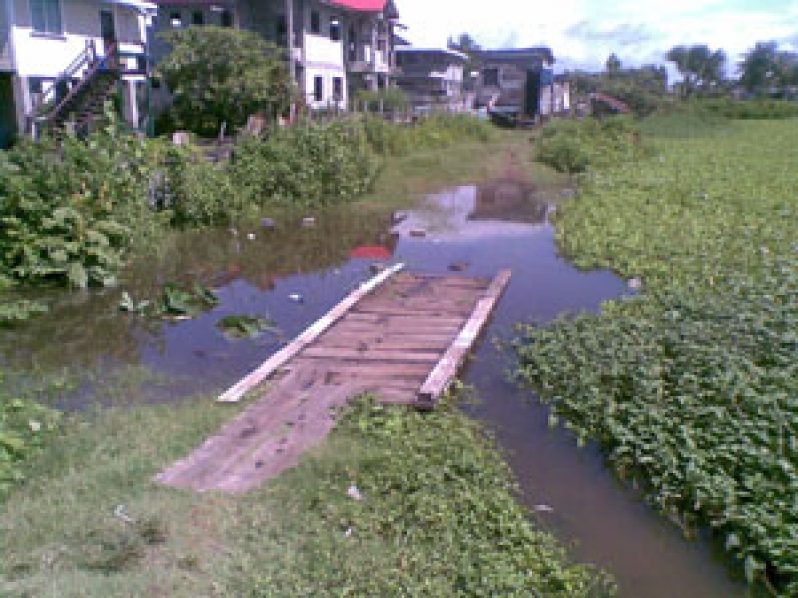BASKING in the glory of the refreshing country breeze licking at my hair, I toyed with the idea of whether I should start my trek from the very beginning of this remotely ‘yesteryear-looking village’, or travel to the very centre and begin my exploration.
 I was almost at the village called Vryheid’s Lust, an East Coast Demerara settlement nestling cozily between the much larger villages of Better Hope and Success. I finally ended my musing and decided to begin my exploration from the vicinity of the Vryheid’s Lust Primary School, and was instantly taken aback by the amount of towering shrubs and weeds that seemed to engulf the entire drainage canal in front of the school.
I was almost at the village called Vryheid’s Lust, an East Coast Demerara settlement nestling cozily between the much larger villages of Better Hope and Success. I finally ended my musing and decided to begin my exploration from the vicinity of the Vryheid’s Lust Primary School, and was instantly taken aback by the amount of towering shrubs and weeds that seemed to engulf the entire drainage canal in front of the school.
With the hot midday sun beating down on us mercilessly, we began our trek around the village, and I have to agree it was a very pleasant and breathtaking experience.
Vryheid’s Lust is located some seven miles from the Garden City of Georgetown, and sports a refreshing cluster of houses in a neighbourhood that is still somewhat festive, despite being faced with many challenges.
Seemingly comfy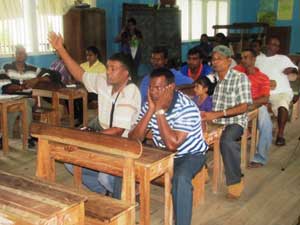
As we trekked around the village, I could not help savouring its utter simplicity, the contentment evident in the smiling faces of residents, and the very distinct yesteryear aura that pervaded the village, even as the apparent tentacles of modernisation were vividly encroaching.
As daring bus drivers attempted to negotiate paths around large potholes in deplorable roads, residents were seemingly bemused by this feat, since this spectacle must have become an ‘everyday thing’ to them.
Vendors plying their trade in small grocery stalls along the main road noisily attempted to attract attention of potential buyers, each trying their best to outdo the other with ‘sweet words’, and even bemoaning lamentations in some cases.  In this arena, it is ‘dog eat dog’, as some would say, and each vendor knows that, with the never-ending competition, they have to come up with creative ways to net major sales, or perish.
In this arena, it is ‘dog eat dog’, as some would say, and each vendor knows that, with the never-ending competition, they have to come up with creative ways to net major sales, or perish.
Cries of ‘Come get yuh fresh provisions and vegetables!” filled the air and competed for audience with wails of “Ow uncle, come patanise me nah? Come buy something fuh dem children home nah?”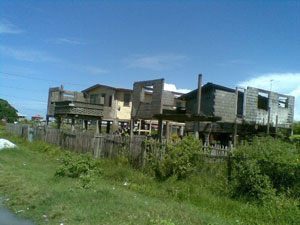
Some even rushed at you with their produce or items, insisting that you inspect them for authenticity and freshness.
We stopped to chat with the seemingly quiet and secluded Brenda Small, a vendor of five years’ standing, and surprisingly, she was ready to discourse with us. Throwing her hands up in disgust, she rudely mouthed, “Nah bada with dem dah… running about and bombarding de people ain’t gon get dem no sales!”
She seemingly preferred to sit quietly and flash one of her most dashing toothless smiles, letting her cherry dimples beckon the customers.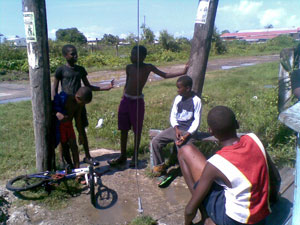 Brenda’s vending fends for her three children, since she is a single-parent mother; and although the job could get gruelling at times, she continues to hold the fort because it is her main source of livelihood.
Brenda’s vending fends for her three children, since she is a single-parent mother; and although the job could get gruelling at times, she continues to hold the fort because it is her main source of livelihood.
“I doing this (vending) fuh years now, and the stiff competition does mek me want give up sometime and guh do ah security wuk. Dem children fatha does hardly send money regularly, suh me gat fuh come out heah every day and throw out me belly. But the Lard does bless me in me lil quiet karnah, and sales does be bountiful many times.”
As we moved around, we were pleasantly arrested by the sight of little boys’ prancing and cavorting in the streets. Their squeals and boyish laughter filled the air and quite often small fights and squabbles broke out over disagreement during their marble or cricket games.
Bright eyed little girls looked on amusingly with pony tails sticking out crazily in all directions. As they chomped noisily on mangoes or cashews, which seemed to be in season, they would rush to their brother’s rescue when the fights broke out, and pulling off rubber slippers, would deal the opponent several lashes before scurrying to safety.
Interacting
Residents there were a bit queasy about talking to the media at the beginning, but soon after our introduction and fitting into their 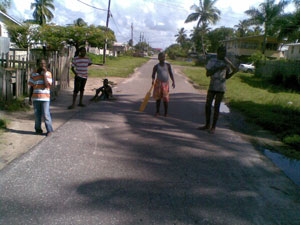 ‘ghetto banter’, the news began to flow as the villagers would have had, it said.
‘ghetto banter’, the news began to flow as the villagers would have had, it said.
We were readily informed by youths playing cards at a nearby shop that the village fares better now, whereas it was once very underdeveloped, even until the late 1990s. While they emphasised that life was getting better by the day, they still pleaded for assistance in the areas of proper drainage, poorly maintained roads, and the need for recreational opportunities for the youths in the village.
Filling us in on the evolution of the village, bus driver Kenneth Earle said that way back in the 1980s, Vryheid’s Lust was a small settlement that had sprung off from the ‘dawn of the sugar estates’, and after slavery was abolished’.
He said that the area was always very swampy and the few settlers that lived their were forced to deal with the snakes, crocodiles and other water creatures that crawled out of the small swamps, especially during moonlight nights. He said as time progressed more and more persons began to settle on the location slowly transforming the location into a seemingly ‘old age village’.
According to Mr. Earle, Vryheid’s Lust began to really take shape by the early 1990’s as residents began to occupy the swampy pastures, spending largely to build and rectify such unsuitable areas to make it proper for comfortable living.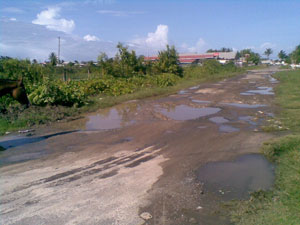 Residents soon turned a large plot of land into a playfield but this is certainly a ‘dry weather playground’ as villagers like to call it since it floods entirely the minute the rain begins to fall. According to Earle the dead and decomposed suffers the most since the entire Vryheid’s Lust cemetery become submerged in water.
Residents soon turned a large plot of land into a playfield but this is certainly a ‘dry weather playground’ as villagers like to call it since it floods entirely the minute the rain begins to fall. According to Earle the dead and decomposed suffers the most since the entire Vryheid’s Lust cemetery become submerged in water.
Earle said this is the worst time for residents since the rotten scent of decomposed bodies in many cases would have resident squirming and holding their breaths upon passing the area.
Soon there became two churches for worship, built by residents themselves of course, and soon after everyone seemed to take on an ‘economic brain’ of their own. Some erected shops and small stalls in which they sell vegetables and groceries, and many took to the banks for loans and bought minibuses.
Today the village is no longer a small cluster of houses, but instead an area where residents are trying desperately to rectify the land and are building posh houses and business that are certainly giving it a somewhat modern transfusion. However, its old world charm is still evident and is made more pronounced with the ‘olden day buildings’ that still remain.
Beautiful but challenging
The contentment and apparent charming demeanour of villagers is to be accredited since despite the fact the fact that they are faced with a few challenges, they still pause and make time to thank the Creator for life and for the bright sunshine.
Village elde, ‘Miss Sheiko’ as she is more popularly known spoke of a few setbacks and many times despite her old age, she really got all fired up over the issues of bad drainage, continuous flooding during rainy season, and the intolerable roads in the village.
“I have lived here since I was a little girl, in the days when there wasn’t even any electricity, and I have to agree that live is good in this village. Taking into consideration from whence we came, things are splendid here in terms of village camaraderie and co-operation amongst residents.
But I am seriously wondering if the authorities responsible for drainage in this area have fallen asleep or something. We have lamented to the NDC people for all these years but still today we are faced with immense flooding, terrible roads and the lack of street lights in some areas. That is all we begging for…. Not a thing more…”
And throughout the village residents seemed content with life as it is, saved for the lamentations on flooding, drainage, lack of recreational facilities, and the need for street lights.
Bountiful fruits
The residents of Vryheid’s Lust Village are definitely hard working and believe in toiling to receive the fruits of life and their just rewards.
And one may be surprised to discover that many of the stately houses that have been erected over times came about as a result of extensive poultry farming by residents, and this still seems to be the order of the day.
In times gone by there were quite a few farmers in the village and they would occupy the back land areas. However, today things have changed and save for a few kitchen gardens, there is no farming still being done in this location. Pigs, cattle and chickens are surely bringing in a fast dollar and residents are capitalizing on such lucrative opportunities.
And the village was lucky to get a little overseas assistance min May 2012 when overseas based Guyanese Jean Marks embarked on an impressive initiative to spruce up the village.
This projects entailed massive self help efforts by village to clean up the massive garbage heap which was created in the cemetery by villagers and outsiders who would sneak into the village by nights to dump huge piles of refuse.
Mrs. Jean March, who lives in London, had organized to get more than four truckloads of builder’s waste, to help repair several roads within the community and a garbage truck to remove the garbage build-up in the cemetery and other areas.
According to Mrs. March, upon her return to her homeland several years ago she saw the need for better access into the village. The woman said that a number of buses had stopped coming into the community because of the deplorable roads.
March said that a fair amount of funds was raised and the project began, but she received unfavourable response from young men in the village to assist. She started the work with another individual and after ten minutes, it seemed as if the entire village came out to assist.
According to residents, the main access road was repaired by the government almost four years ago, but the cross streets have not been repaired for well over ten years.
The woman said that she has teamed up with another overseas-based Guyanese to finish another project they are planning.
Mr. Winston Dyer who lives in the USA, and Mrs March have undertaken to get the community field and community centre more developed, but this is an almost impossible task because of flooding in the area.
Employment dilemma
Well most villages we had visited either had an employment crisis or cases where qualified persons could not function in their area. Vryheid’s Lust seemed to have a totally different situation going on.
According to Kenneth Earle youngsters in the village between the ages of eighteen and twenty six are shockingly content to sit by the roadside and lime all day, without making any effort to become gainfully employed. He said that the village indeed allows a little scope for employment but the young men are just lazy and prefer to sit around guffawing and behaving like four year-olds.
Make me wonder why the parents are not urging them to get a job or throwing them out if they refuse.
That aside, a few persons are employed as teachers in and outside the village, while some are filling positions in the administrative offices in the city. There are a few that will brave the dangers of the interior regions to do pork-knocking, while some are mini-bus and hire car drivers.
An attractive village
The infrastructure of Vryheid’s Lust is very enticing in many areas and the arrangement of beautiful flower plants and trees in yards are a ‘must see spectacle’. Well kept years and flower orchids add even more of a feisty, tropical allure to the location.
There are no discos or nightclubs there so most persons would go to the ‘party hive’ which is the neighbouring Plaisance Village for frolic and fun, or journey to Georgetown when they can enjoy variety amongst party concepts.
Despite its bad roads, and drainage problems, Vryheid’s Lust has evolved nicely into a village that shows great signs of economic boom in time to come, but at presently is certainly the village you will want to visit for a little relaxation, and to connect with one’s ‘inner me’.



.jpg)



